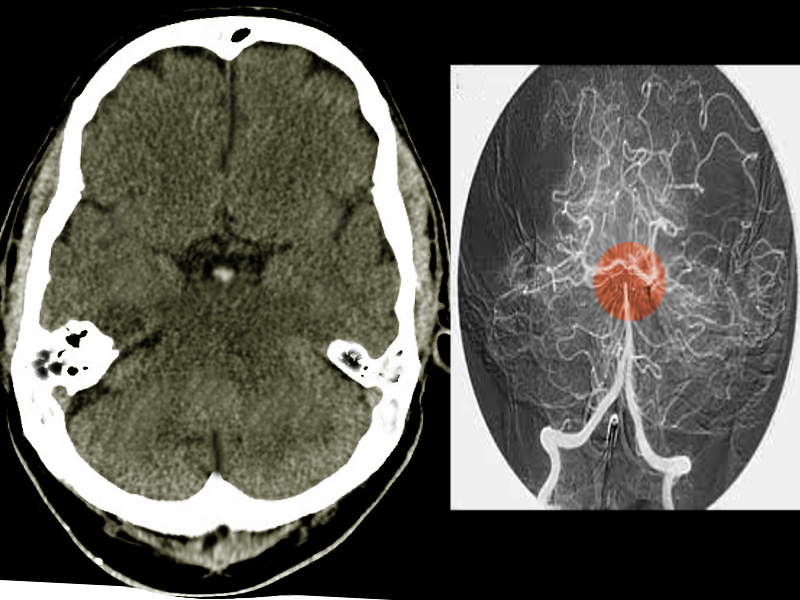[1]
Nagel S. [Stroke due to acute occlusion of the basilar artery : Diagnosis and treatment]. Medizinische Klinik, Intensivmedizin und Notfallmedizin. 2017 Nov:112(8):679-686. doi: 10.1007/s00063-017-0347-0. Epub 2017 Sep 13
[PubMed PMID: 28905077]
[2]
Schulz UG, Fischer U. Posterior circulation cerebrovascular syndromes: diagnosis and management. Journal of neurology, neurosurgery, and psychiatry. 2017 Jan:88(1):45-53. doi: 10.1136/jnnp-2015-311299. Epub 2016 Apr 12
[PubMed PMID: 27071644]
[3]
Kjerpeseth LJ, Ellekjær H, Selmer R, Ariansen I, Furu K, Skovlund E. Risk factors for stroke and choice of oral anticoagulant in atrial fibrillation. European journal of clinical pharmacology. 2018 Dec:74(12):1653-1662. doi: 10.1007/s00228-018-2540-3. Epub 2018 Aug 16
[PubMed PMID: 30116828]
[4]
Ekker MS, Boot EM, Singhal AB, Tan KS, Debette S, Tuladhar AM, de Leeuw FE. Epidemiology, aetiology, and management of ischaemic stroke in young adults. The Lancet. Neurology. 2018 Sep:17(9):790-801. doi: 10.1016/S1474-4422(18)30233-3. Epub
[PubMed PMID: 30129475]
[5]
Wang L, He M, Zhang Y. Risk factors associated with extracranial atherosclerosis in old patients with acute ischemic stroke. Scientific reports. 2018 Aug 22:8(1):12541. doi: 10.1038/s41598-018-31026-z. Epub 2018 Aug 22
[PubMed PMID: 30135472]
[6]
Ausman JI, Liebeskind DS, Gonzalez N, Saver J, Martin N, Villablanca JP, Vespa P, Duckwiler G, Jahan R, Niu T, Salamon N, Yoo B, Tateshima S, Buitrago Blanco MM, Starkman S. A review of the diagnosis and management of vertebral basilar (posterior) circulation disease. Surgical neurology international. 2018:9():106. doi: 10.4103/sni.sni_373_17. Epub 2018 May 24
[PubMed PMID: 29930872]
[7]
McDermott M, Jacobs T, Morgenstern L. Critical care in acute ischemic stroke. Handbook of clinical neurology. 2017:140():153-176. doi: 10.1016/B978-0-444-63600-3.00010-6. Epub
[PubMed PMID: 28187798]
[8]
Johnson TM, Romero CS, Smith AT. Locked-in syndrome responding to thrombolytic therapy. The American journal of emergency medicine. 2018 Oct:36(10):1928.e5-1928.e7. doi: 10.1016/j.ajem.2018.07.003. Epub 2018 Jul 3
[PubMed PMID: 29983216]
[9]
Reid M, Famuyide AO, Forkert ND, Sahand Talai A, Evans JW, Sitaram A, Hafeez M, Najm M, Menon BK, Demchuk A, Goyal M, Sah RG, d'Esterre CD, Barber P. Accuracy and Reliability of Multiphase CTA Perfusion for Identifying Ischemic Core. Clinical neuroradiology. 2019 Sep:29(3):543-552. doi: 10.1007/s00062-018-0717-x. Epub 2018 Aug 21
[PubMed PMID: 30132089]
[10]
Kadoya Y, Zen K, Oda Y, Matoba S. Successful Endovascular Treatment for Aortic Thrombosis Due to Primary Antiphospholipid Syndrome: A Case Report and Literature Review. Vascular and endovascular surgery. 2019 Jan:53(1):51-57. doi: 10.1177/1538574418791355. Epub 2018 Aug 9
[PubMed PMID: 30092725]
Level 3 (low-level) evidence
[11]
Sugrue G, O'Reilly MK, Byrne D, Crockett MT, Murphy S, Kavanagh EC. CT cervico-cerebral angiography in acute stroke. Can we justify aortic arch imaging? Irish journal of medical science. 2019 May:188(2):661-666. doi: 10.1007/s11845-018-1888-9. Epub 2018 Aug 24
[PubMed PMID: 30143966]
[12]
Campbell BC, Parsons MW. Imaging selection for acute stroke intervention. International journal of stroke : official journal of the International Stroke Society. 2018 Aug:13(6):554-567. doi: 10.1177/1747493018765235. Epub 2018 Mar 15
[PubMed PMID: 29543140]
[13]
Safdarian M, Rohani M. Basilar Artery Thrombosis on Brain MRI. The Neurohospitalist. 2018 Jul:8(3):NP3. doi: 10.1177/1941874417733218. Epub 2017 Sep 25
[PubMed PMID: 29977452]
[14]
Kheiri B, Osman M, Abdalla A, Haykal T, Ahmed S, Hassan M, Bachuwa G, Al Qasmi M, Bhatt DL. Tenecteplase versus alteplase for management of acute ischemic stroke: a pairwise and network meta-analysis of randomized clinical trials. Journal of thrombosis and thrombolysis. 2018 Nov:46(4):440-450. doi: 10.1007/s11239-018-1721-3. Epub
[PubMed PMID: 30117036]
Level 1 (high-level) evidence
[15]
Chen CJ, Chuang TY, Hansen L, Dutta S, Ding D, Buell TJ, Ironside N, Patibandla MR, Southerland AM, Worrall BB, Kalani MYS. Predictors of 30-day mortality after endovascular mechanical thrombectomy for acute ischemic stroke. Journal of clinical neuroscience : official journal of the Neurosurgical Society of Australasia. 2018 Nov:57():38-42. doi: 10.1016/j.jocn.2018.08.044. Epub 2018 Aug 23
[PubMed PMID: 30145087]
[16]
Xiong YJ, Gong JM, Zhang YC, Zhao XL, Xu SB, Pan DJ, Qu WS, Tian DS. Endovascular thrombectomy versus medical treatment for large vessel occlusion stroke with mild symptoms: A meta-analysis. PloS one. 2018:13(8):e0203066. doi: 10.1371/journal.pone.0203066. Epub 2018 Aug 23
[PubMed PMID: 30138460]
Level 1 (high-level) evidence
[17]
Aronov MS, Popugaev KA, Udalov YD, Samoylov AS. [Endovascular treatment of acute ischemic stroke]. Zhurnal voprosy neirokhirurgii imeni N. N. Burdenko. 2018:82(4):103-108. doi: 10.17116/neiro2018824103. Epub
[PubMed PMID: 30137044]
[18]
Moussaddy A, Demchuk AM, Hill MD. Thrombolytic therapies for ischemic stroke: Triumphs and future challenges. Neuropharmacology. 2018 May 15:134(Pt B):272-279. doi: 10.1016/j.neuropharm.2017.11.010. Epub 2018 Mar 3
[PubMed PMID: 29505787]
[19]
Ritvonen J, Strbian D, Silvennoinen H, Virtanen P, Salonen O, Lindsberg PJ, Sairanen T. Thrombolysis and adjunct anticoagulation in patients with acute basilar artery occlusion. European journal of neurology. 2019 Jan:26(1):128-135. doi: 10.1111/ene.13781. Epub 2018 Sep 12
[PubMed PMID: 30134080]
[20]
Neves Briard J, Zewude RT, Kate MP, Rowe BH, Buck B, Butcher K, Gioia LC. Stroke Mimics Transported by Emergency Medical Services to a Comprehensive Stroke Center: The Magnitude of the Problem. Journal of stroke and cerebrovascular diseases : the official journal of National Stroke Association. 2018 Oct:27(10):2738-2745. doi: 10.1016/j.jstrokecerebrovasdis.2018.05.046. Epub 2018 Jul 26
[PubMed PMID: 30056002]
[21]
Okano Y, Ishimatsu K, Kato Y, Yamaga J, Kuwahara K, Okumoto K, Wada K. Clinical features of stroke mimics in the emergency department. Acute medicine & surgery. 2018 Jul:5(3):241-248. doi: 10.1002/ams2.338. Epub 2018 Apr 10
[PubMed PMID: 29988676]
[22]
Chatterjee SA, Daly JJ, Porges EC, Fox EJ, Rose DK, McGuirk TE, Otzel DM, Butera KA, Clark DJ. Mobility Function and Recovery After Stroke: Preliminary Insights From Sympathetic Nervous System Activity. Journal of neurologic physical therapy : JNPT. 2018 Oct:42(4):224-232. doi: 10.1097/NPT.0000000000000238. Epub
[PubMed PMID: 30138228]

